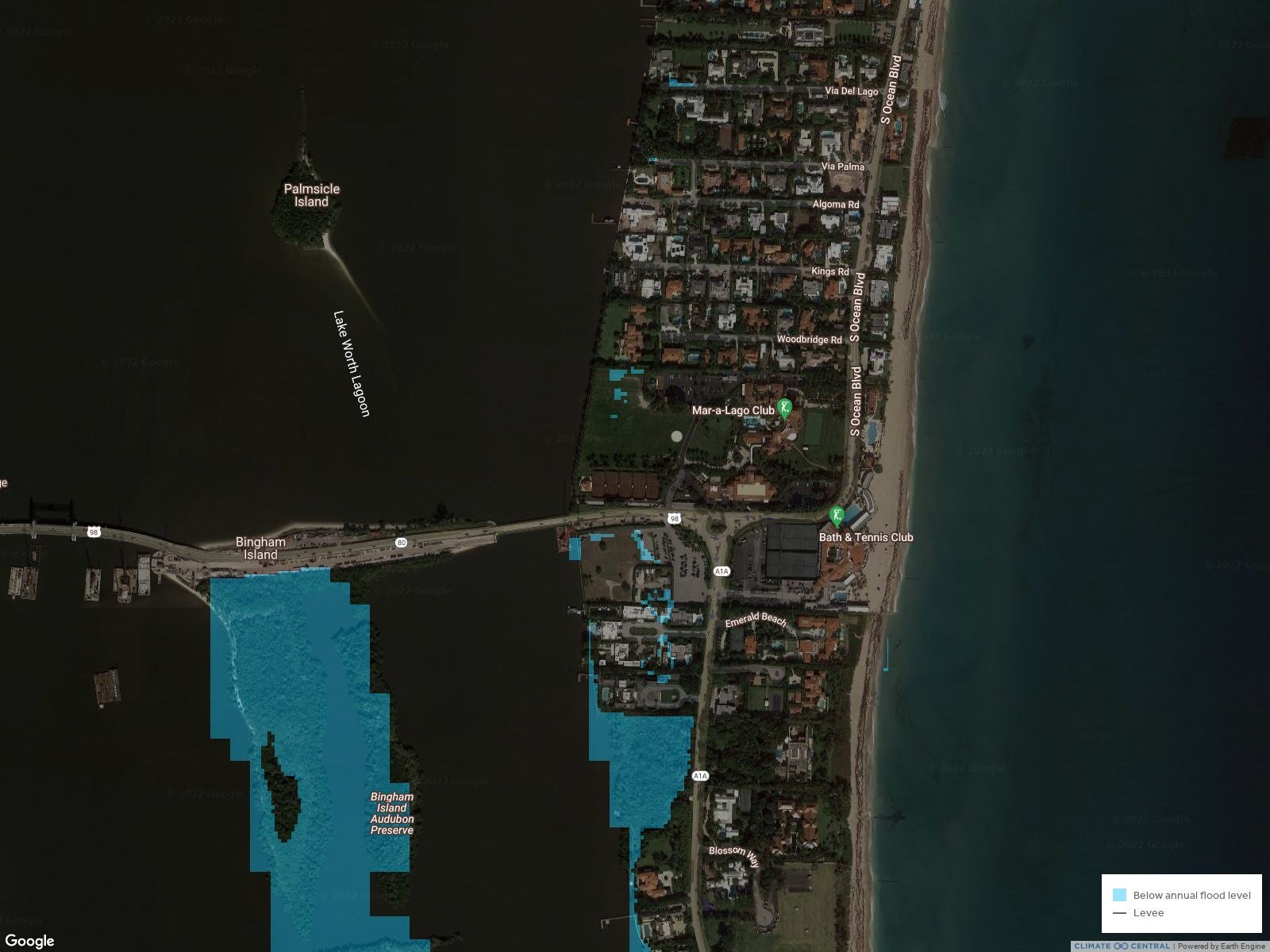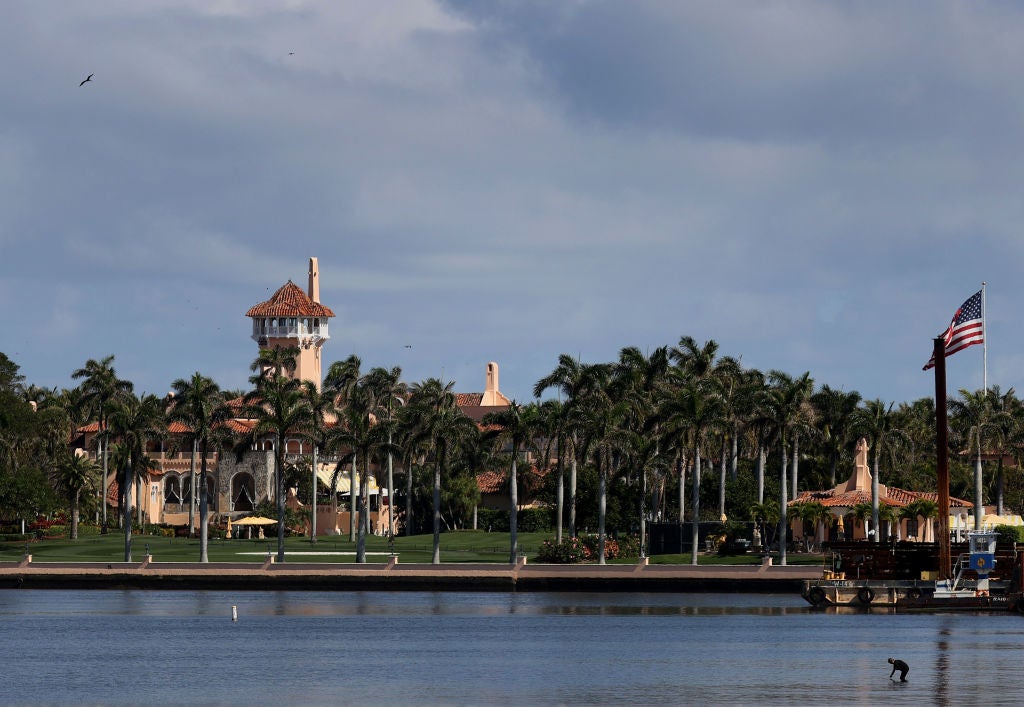Trump claims sea level rise means more ‘beachfront property’. Let’s take a look at Mar-a-Lago
‘We’ll have a little bit more beachfront property, that’s not the worst thing in the world,’ Mr Trump told a crowd in Alaska, where warming is occuring at twice the rate of any other US state
Your support helps us to tell the story
From reproductive rights to climate change to Big Tech, The Independent is on the ground when the story is developing. Whether it's investigating the financials of Elon Musk's pro-Trump PAC or producing our latest documentary, 'The A Word', which shines a light on the American women fighting for reproductive rights, we know how important it is to parse out the facts from the messaging.
At such a critical moment in US history, we need reporters on the ground. Your donation allows us to keep sending journalists to speak to both sides of the story.
The Independent is trusted by Americans across the entire political spectrum. And unlike many other quality news outlets, we choose not to lock Americans out of our reporting and analysis with paywalls. We believe quality journalism should be available to everyone, paid for by those who can afford it.
Your support makes all the difference.Donald Trump’s appearance at a GOP rally in Alaska on Saturday night was a wild ride of F-bombs, rants about Elon Musk, and a refusal to say the word “vaccine”.
The event, to drum up support for Republican Senate candidate Kelly Tshibaka and House candidate Sarah Palin, also included a repeat of the climate denial schtick that Mr Trump has rolled out over the past few months.
“You can worry about nuclear warming but you can’t worry about the global warming,” he said. “They said the other day that the oceans are going to rise one-eighth of an inch over the next 300 years. We have bigger problems than that.
“We’ll have a little bit more beachfront property, that’s not the worst thing in the world,” he said to roars of laughter from the crowd.
The climate crisis is bringing rapid change to Alaska, where warming is occurring at least twice as fast as any other US state. The impacts are already severe: fire seasons have become more intense and unpredictable, with an estimated 260 blazes burning on Monday, the Alaska Interagency Coordination Center reported.
Sea level rise is no longer a future threat. The rapid melt of sea ice and glaciers that define much of the far northern landscape is now underway at pace.
According to the latest US government climate assessment, average Arctic sea ice has been declining about 4 per cent every decade. Between 1994 and 2013, the state lost about 75 gigatons of glacial ice annually (around 10,000 times as heavy as the Great Pyramid of Giza).
For some communities, devastation has arrived. Indigenous communities, like the village of Kivalina on the far northern coast, are witnessing their homes fall into the ocean. The village, built on a barrier island, likely has just years left before erosion and rising seas like mean it will need to be abandoned.
At the other end of the country, in the former president’s adopted home state of Florida, many residents are now also keenly aware that sea level rise is no laughing matter.
Florida tops the list for sea level-rise in the US. Average sea level along the US coastline is expected to rise by 10 - 12 inches (25-30cm) in the next 30 years, according to a 2022 update from the US National and Oceanic Atmospheric Administration (NOAA).
Globally, seas have risen six to eight inches (15-20 cm) over the last century, a rate that has accelerated in the past two decades. More than 90 per cent of excess heat in the atmosphere – caused by greenhouse gas emissions from burning oil, gas and coal – is absorbed by the ocean. Heat causes water to expand and raises sea levels, with melting glaciers and ice sheets compounding the problem.
In the US, coastal flooding will worsen, NOAA says. Higher sea levels mean higher tides and storm surges, pushing water further inland. By 2050, “moderate” flooding – the kind which causes damage – will happen more than 10 times as often as it does today, on average.
This means serious problems for low-lying southern Florida, where Mr Trump lives at the Mar-a-Lago estate. The Republican bought the 123-room mansion in 1985 after driving down its price and has spent millions on renovations in the intervening decades.

Located on a barrier island of Palm Beach, the private club, and its neighbouring multi million-dollar properties, are surrounded by water, with the Atlantic Ocean to the east and Florida’s Intracoastal Waterway to the west.
Nearly two-thirds of properties in Palm Beach are designated as “special flood hazard area” by the Federal Emergency Management Agency, the US government’s disaster-response branch.
Sea level rise will have myriad impacts on the Sunshine State. Firstly, three-quarters of the population live in coastal areas. This means more people and homes in harm’s way of flooding and storm surges which can accompany the increasingly powerful hurricanes being fuelled by warm water.
Millions of people, particularly in Miami-Dade and Broward counties just south of Palm Beach, live on land within four feet of the local high tide line. Sea level rise more than doubles risk of a storm surge at this level in South Florida by 2030, the nonprofit Climate Central reports.
Even outside of hurricane season, Florida communities are experiencing flooded storm drains, roads and infrastructure during high tide.

The state sits on porous bedrock so even small amounts of sea level rise can have salty water seeping into the foundations of buildings and freshwater supplies.
During Hurricane Sandy in 2012, rushing water destroyed and damaged sea wall defences of homes near Mar-a-Lago. Palm Beach County was left with a major restoration job along the eroded shoreline.
In 2017, Mar-a-Lago staff and guests were among a mass evacuation ahead of Category-5 Hurricane Irma making landfall. Five people died in Palm Beach County and the cyclone caused an estimated $50bn in damage to the state, the costliest hurricane in Florida history.
Over the next 30 years, 2,386 properties in Palm Beach have a one-in-five chance of being severely affected by flooding, reports FloodFactor, representing 82 per cent of buildings in the city.
Mar-a-Lago is unlikely to escape. Even with conservative projections of sea level rise, water could be sloshing over Mar-a-Lago’s manicured lawns from the intracoastal waterway in the next 30 years, according to Climate Central’s coastal risk screening tool based on the latest NOAA data.
Flooding is also expected to impact neighbouring properties and roads on the barrier island, and threaten a bridge which provides access to mainland Florida.
A 2016 analysis, published by the Guardian, found that by 2045, “storm surge from even a category two storm would bring waters crashing over the main swimming pool and up to the main building” of Mar-a-Lago.
And it’s not Mr Trump’s only at-risk property in Florida. There’s also the Trump International Beach Resort and his Doral golf course, both located further south in the Miami area.
The Independent has contacted representatives for Mr Trump and Mar-a-Lago for comment.
The long-term severity of sea level rise will depend on how seriously countries tackle still-rising carbon emissions, scientists say.
However according to the most recent accounting from the authoritative Intergovernmental Panel on Climate Change, some damage is already “baked in”.
It is “virtually certain” that global sea levels will continue to rise this century but beyond 2050, projections become increasingly sensitive to “emission choices we are making today”, according to the report’s authors.
Scientists have a less clear picture of what will happen if global heating continues to rise, particularly when it comes to catastrophic events like the collapse of the polar ice sheets.
NOAA has also issued “extreme” sea level projections, a so-called “Doomsday” scenario. While unlikely, it would see a 10- to 12-foot rise in US sea levels by the end of the century, leaving large parts of southern Florida including Miami (but also major coastal cities like New York and Boston) underwater.
Florida is investing billions in near-term preparations. Republican Governor Ron DeSantis, a potential Trump rival for 2024, announced a “Resilient Florida” program last year, which will provide $1bn in grants to help local authorities adapt to climate risks.
This means a rollout of strategies like raising roads, bridges and buildings and installing high-tech pumping systems. In some instances, communities are beginning to retreat from rising seas entirely.
Jim Cason, the former Republican mayor of the south Florida city of Coral Gables, called sea level rise an “existential issue”.
“In 30 years Florida will see many more days of flooding, stronger storms, more extreme weather, and stagnant or declining coastal property values,” he said.
This article was originally published in March 2022



Join our commenting forum
Join thought-provoking conversations, follow other Independent readers and see their replies
Comments